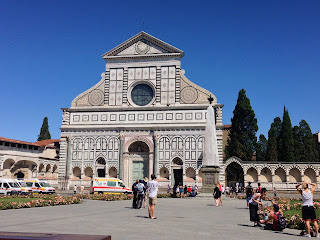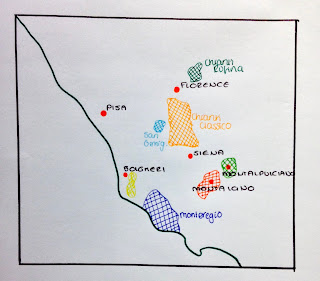Who were the Medici family?
The Medici family gets a mention in every book I'm reading at the moment - so let's find out who this mysterious and important family were.
From banking, to political power, to a royal household - but how did they get here?
The Medici family or the House of Medici as they are known, are first mentioned way back in 1230 and were originally from the Mugello region, just North of Florence. They were in the textile trade, which also links into their passion for turning Florence into an environment where art and humanism flourished, and with help from a number of other families in Italy, inspired the birth of the Italian Renaissance. But from their humble beginnings in the Tuscan countryside, they decided to up sticks and relocate to Florence.
In the 13th century, Giovanni di Bicci de' Medici founded the Medici Bank (and a taxing system), which became the largest in Europe in the 15th century, and saw the Medici family being the most wealthiest families at the time. The family gained political power in Florence, then Italy and onto Europe. Their social status was also growing, through connections to notable families by marriage, employment and partnerships. Giovanni's son Cosimo the Elder (Pater Patriae) took over in 1434, and the family became unofficial heads of state for Florence. Cosimo gave much support to the arts and humanities made in Florence through the Renaissance, and supported artists such as Ghiberti, Brunelleschi, Donatello and Fra Angelico. The family also produced 4 popes (Leo X, Clement VII, Pius IV and Leon XI), and their genes were mixed into many of Europe’s royal families. The last Medici ruler died without a male heir in 1737, ending the family dynasty after almost three centuries.
During Cosimo’s time, as well as that of his sons and particularly his grandson, Lorenzo the Magnificent (1449-1492), Renaissance culture flourished, and Florence became the cultural center of Europe.
Lorenzo was a poet, and a follower of works from Botticelli, Leonardo da Vinci and Michelangelo. When he died, his eldest son Piero succeeded him, but exiled only 2 years later. Luckily the Medici family was able to return to Florence in 1512. The next few years were very important, as Leo X took over, and devtoed himself to artistic patronage. Piero’s son, also named Lorenzo, regained power in Florence, and his daughter Catherine (1519-1589) became queen of France through her marriage to King Henry II; three of her four sons would rule France as well.
By the 1500's, few descendants of Cosimo the Elder remained, Lorenzo the Elder (descendant of Cosimos brother) came forward to launch a new Medici dynasty. His great-great grandson Cosimo became duke of Florence in 1537, then Grand Duke of Tuscany in 1569.
Male heirs were getting were in decline, leading to the last Medici Grand Duke, Gian Gastone dying without a male heir in 1737. European peers from Austria, France, England and the Netherlands passed control to Francis of Lorraine.
Interesting family members;
Piero de' Medici; Cosimo's son, also known as "Piero the Gouty" because of his gout problems, which eventually led to his death.
Lorenzo de' Medici (1449–1492), also known as "the Magnificent", concentrated on leading and ruling the city, but ended up neglecting the family banking business, which led to its ultimate ruin.
In 1478, there was a conspiracy to kill Lorenzo with his younger brother Giuliano during Easter services; Guiliano died, and Lorenzo only injured. The conspiracy involved 2 rival banking families; the Pazzi and Salviati families, who wanted to end the Medici's families success. Even the priest presiding over the church services, the Archbishop of Pisa, and even Pope Sixtus IV to a degree were thought to be in on it!
From banking, to political power, to a royal household - but how did they get here?
The Medici family or the House of Medici as they are known, are first mentioned way back in 1230 and were originally from the Mugello region, just North of Florence. They were in the textile trade, which also links into their passion for turning Florence into an environment where art and humanism flourished, and with help from a number of other families in Italy, inspired the birth of the Italian Renaissance. But from their humble beginnings in the Tuscan countryside, they decided to up sticks and relocate to Florence.
In the 13th century, Giovanni di Bicci de' Medici founded the Medici Bank (and a taxing system), which became the largest in Europe in the 15th century, and saw the Medici family being the most wealthiest families at the time. The family gained political power in Florence, then Italy and onto Europe. Their social status was also growing, through connections to notable families by marriage, employment and partnerships. Giovanni's son Cosimo the Elder (Pater Patriae) took over in 1434, and the family became unofficial heads of state for Florence. Cosimo gave much support to the arts and humanities made in Florence through the Renaissance, and supported artists such as Ghiberti, Brunelleschi, Donatello and Fra Angelico. The family also produced 4 popes (Leo X, Clement VII, Pius IV and Leon XI), and their genes were mixed into many of Europe’s royal families. The last Medici ruler died without a male heir in 1737, ending the family dynasty after almost three centuries.
During Cosimo’s time, as well as that of his sons and particularly his grandson, Lorenzo the Magnificent (1449-1492), Renaissance culture flourished, and Florence became the cultural center of Europe.
Lorenzo was a poet, and a follower of works from Botticelli, Leonardo da Vinci and Michelangelo. When he died, his eldest son Piero succeeded him, but exiled only 2 years later. Luckily the Medici family was able to return to Florence in 1512. The next few years were very important, as Leo X took over, and devtoed himself to artistic patronage. Piero’s son, also named Lorenzo, regained power in Florence, and his daughter Catherine (1519-1589) became queen of France through her marriage to King Henry II; three of her four sons would rule France as well.
By the 1500's, few descendants of Cosimo the Elder remained, Lorenzo the Elder (descendant of Cosimos brother) came forward to launch a new Medici dynasty. His great-great grandson Cosimo became duke of Florence in 1537, then Grand Duke of Tuscany in 1569.
Male heirs were getting were in decline, leading to the last Medici Grand Duke, Gian Gastone dying without a male heir in 1737. European peers from Austria, France, England and the Netherlands passed control to Francis of Lorraine.
Interesting family members;
Piero de' Medici; Cosimo's son, also known as "Piero the Gouty" because of his gout problems, which eventually led to his death.
Lorenzo de' Medici (1449–1492), also known as "the Magnificent", concentrated on leading and ruling the city, but ended up neglecting the family banking business, which led to its ultimate ruin.
In 1478, there was a conspiracy to kill Lorenzo with his younger brother Giuliano during Easter services; Guiliano died, and Lorenzo only injured. The conspiracy involved 2 rival banking families; the Pazzi and Salviati families, who wanted to end the Medici's families success. Even the priest presiding over the church services, the Archbishop of Pisa, and even Pope Sixtus IV to a degree were thought to be in on it!


Comments
Post a Comment